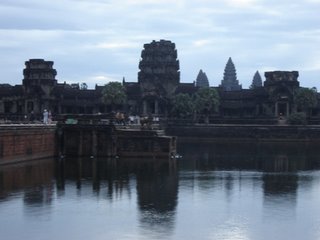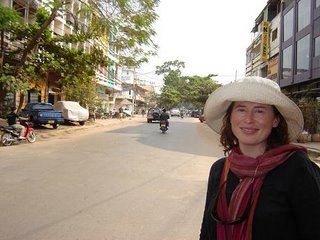 Cambodia's capital, Phnom Penh, reminded me of two European cities. By day you would notice impressive (if occasionally crumbling - see top) French architecture, very much like Paris; meanwhile by night you could pretty much smell the despair, crime and danger of the streets, very much like Liverpool. (Note of apology to my good cousin Duncan).
Cambodia's capital, Phnom Penh, reminded me of two European cities. By day you would notice impressive (if occasionally crumbling - see top) French architecture, very much like Paris; meanwhile by night you could pretty much smell the despair, crime and danger of the streets, very much like Liverpool. (Note of apology to my good cousin Duncan).
Phnom Penh was really an image of the whole of Cambodia - and in truth it is a very tragic image.
 Everywhere we went was terribly polluted (I'm not sure what they use in their motor engines but I'm fairly certain it's not Super Unleaded); the museums and monuments tell appalling tales of genocide and torture under the Khmer Rouge (see right); there are many many cripples (land mine victims mostly); the infrastructure is poor with towns and streets full of dust; there are many beggars; and there are many many none-too-subtle prostitutes and, sadder still, associated packs of unsavoury western males of varying ages.
Everywhere we went was terribly polluted (I'm not sure what they use in their motor engines but I'm fairly certain it's not Super Unleaded); the museums and monuments tell appalling tales of genocide and torture under the Khmer Rouge (see right); there are many many cripples (land mine victims mostly); the infrastructure is poor with towns and streets full of dust; there are many beggars; and there are many many none-too-subtle prostitutes and, sadder still, associated packs of unsavoury western males of varying ages.
 On a brighter note, the people were friendly and very kind when I came down with a bout of food poisoning.
On a brighter note, the people were friendly and very kind when I came down with a bout of food poisoning.
We also came upon what must be some of the world's most intelligent, smart and educated tuk-tuk drivers (see left). But in the context of Cambodia you can't help but see them as a little tragic too: intelligent they may be, but their opportunities to progress are so limited they jump at the chance to take you all around town all day for what, in the UK, is less than the price of a Starbucks Latte.
It might all be more bearable if you felt the country was on a road to recovery, but it's hard to see it. National politics are notoriously corrupt and in a mess, the country has no major natural resources to invest in itself, and even Angkor Wat, the only truly world-class 'resource' it has is managed by a Vietnamese company which takes the lion's share of the profits.
I am very sorry to say it, but you can't help but leave Cambodia with a bitter taste in your mouth - and not just from the dust and toxic fumes which hang everywhere you go.
Joe








































